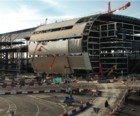Wireless fire system protects new terminal at Dublin during construction

A wireless fire system is providing a flexible and temporary manual fire alert and safety system during the construction of Dublin Airport’s £350 million Terminal 2.
The 5000 FirePoint system from EMS Group is being installed by approved partner Vision Radio Fire in partnership with Alandale Logistics. Wireless operation means there is no need to install and continually move expensive fire-rated cable.
The installation consists of six radio network fire panels interfaced to 35 call points and 35 combined sounder strobe units. They protect the construction of the main arrivals/departure building.
In the event of an emergency, the safety wardens are alerted via an EMS site-wide paging system. If evacuation of an area is necessary, an audible and visual alert can be generated using sounder/strobe units.
As construction progresses, further radio networks with nine more control panels will be installed in three other buildings.
Pat O’Sullivan, managing director of Vision Radio Fire, comments, ‘Terminal 2 is the largest and most complex temporary fire-alert system we have commissioned. Having completed a detailed radio site survey, we were satisfied that despite the large amount of steel and concrete throughout the building, we could provide a secure and stable wireless infrastructure during construction and fit-out.’








